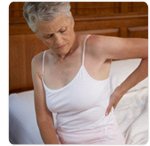
Currently affecting between over 17 million females over the age of 50 in the US, osteoporosis is a condition that lowers bone density and makes women more susceptible to fractures. The parathyroid and estrogen hormones have both been used to treat this illness. The parathyroid hormone reduces vertebral fractures and increases spinal bone density in both postmenopausal osteoporosis and glucocorticoid-induced osteoporosis. Yet, it also decreases radius bone density. It is unclear whether or not this hormone is safe for long-term use.
Primary investigations into PTH have been somewhat disregarded in light of concerns about undesirable effects at non-spine areas. Many researchers claim that combined with estrogen hormones, PTH can have more beneficial effects on osteoporosis patients. This review focuses on evidence on the effectiveness and safety of the PTH and estrogen hormones in treating osteoporosis, examining the possibility that PTH can add to the ability of estrogen hormones replacement therapy to reduce breakages.
A 12-month trial into osteoporosis treatment with PTH plus estrogen hormones found a greater increase in spine and total hip bone mass density (BMD) than with estrogen hormones treatment alone. Yet, changes were not noteworthy with either PTH plus estrogen hormones or estrogen hormones alone at the femoral neck, trochanter, or radius.

Most research into osteoporosis has focused on postmenopausal osteoporosis and has recognized that combined PTH and HRT had no gain over estrogen hormones alone at the hip or radius. The impact of therapy on the radius displayed a very slight decrease compared with estrogen hormones alone. Nevertheless, one particular test into osteoporosis treatment showed a slight BMD increase with PTH plus estrogen hormones compared with estrogen hormones alone at the radius.
When HRT was matched against HRT plus PTH, vertebral fracture occurrences were reduced with PTH plus estrogen hormones vs. estrogen hormones alone, but differences between groups were not extensive.
Some osteoporosis investigations into bone density outcomes have suggested that concurrent PTH and estrogen hormones use had an advantage over estrogen hormones alone at the spine in women suffering from postmenopausal osteoporosis.
Regarding postmenopausal osteoporosis, when combined with standard oral or transdermal estrogen hormones alone, PTH induced improved BMD at the lumbar spine and femoral neck, though not at the femoral trochanter, compared with estrogen hormones alone. However, estrogen and progesterone components were not analyzed independently and it's likely that every hormone component has differing impacts on bone metabolism.
Focusing on postmenopausal osteoporosis, adding PTH to combination HRT or alendronate had advantages over HRT on its own at the lumbar spine, but there are inconsistencies in effects at the radius, trochanter, and hip. In terms of glucocorticoid-induced osteoporosis, combined PTH and estrogen hormones replacement may be of greater benefit compared with estrogen hormones replacement alone at the spine, but often not at the hip or radius. It appears that PTH lowers the rate of radiographically detected spinal fractures, decreases the amount of nonvertebral fractures, and may add to the ability of estrogen hormones replacement therapy to reduce breakages.